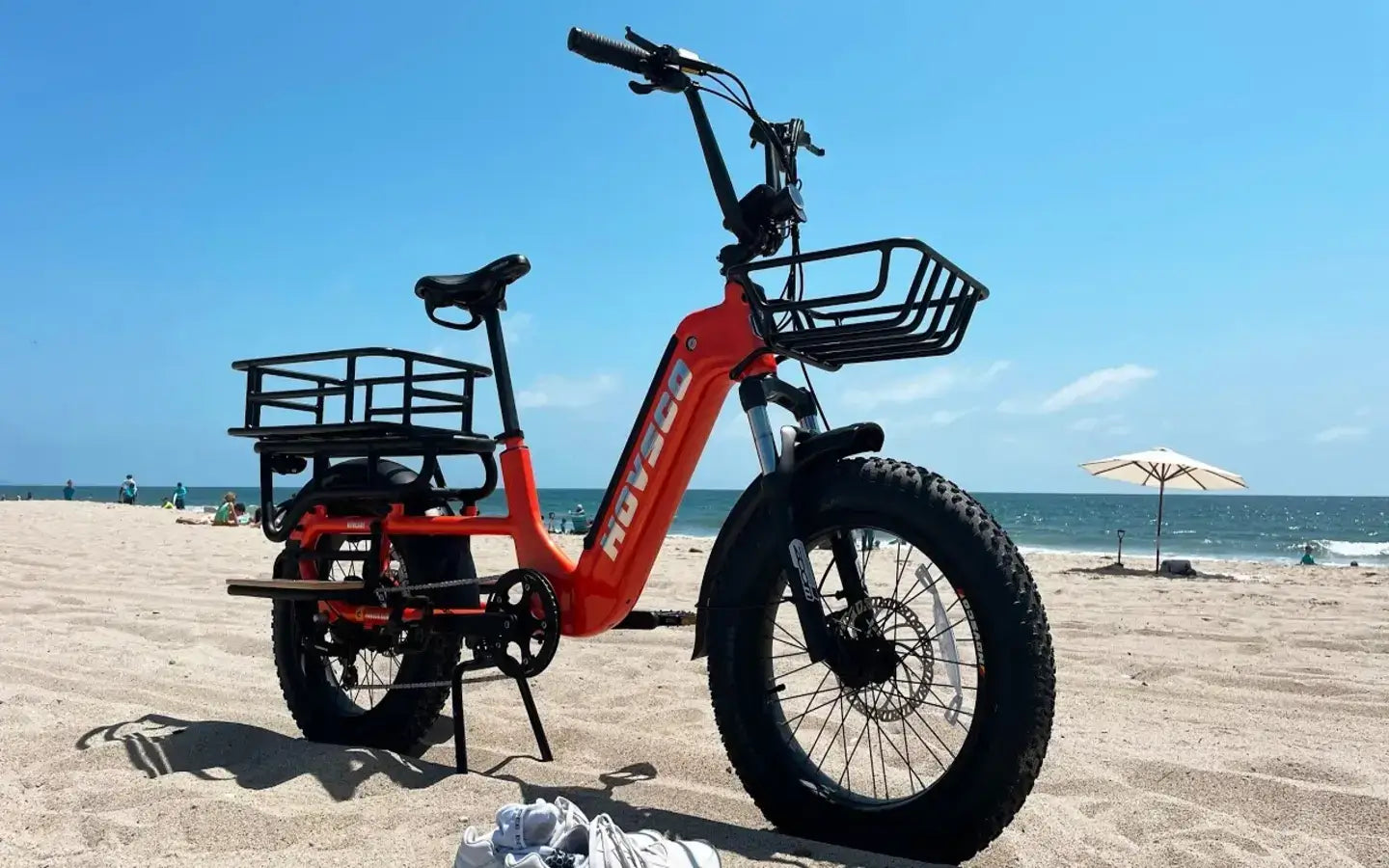
- by LiuJiazhu
What Electric Cruiser Bikes Provide Optimal Long-Distance Ride Comfort?
- by LiuJiazhu
Electric cruiser bikes optimized for long-distance comfort prioritize adjustable ergonomic designs, high-capacity batteries, and suspension systems. Models like the 2024-upgraded 26" Beach Cruiser with a 750W motor and 48V 20Ah battery excel in delivering smooth rides through intelligent pedal assist, fat tires for stability, and reinforced frames. Hydraulic disc brakes ensure safety, while customizable seating and handlebars adapt to diverse body types, making these bikes ideal for extended adventures. Why Choose Full Suspension Ebikes For Rocky Terrain?
Long-distance comfort hinges on ergonomic adjustability, vibration-dampening components, and energy-efficient power systems. Bikes like the 48V 500W folding e-bike use aluminum frames to reduce weight while maintaining durability, paired with wide, padded seats and adjustable stems. A 1:1 smart pedal assist system minimizes rider fatigue by intuitively matching motor output to pedaling effort, crucial for multi-hour rides.
Beyond basic specifications, effective shock absorption separates adequate bikes from exceptional ones. For instance, the 26" fat-tire beach cruiser employs dual-wall rims and steel forks to absorb road vibrations—akin to a car’s independent suspension smoothing rough terrain.
Pro Tip: Prioritize bikes with hydraulic suspension forks over basic spring systems; they dynamically adjust to terrain changes, reducing lower back strain. However, higher torque motors (e.g., 750W) require precise controller calibration to prevent abrupt acceleration, which can compromise rider stability on long descents. What good is a plush seat if the power delivery feels jerky? Manufacturers address this through smart controllers that modulate output based on real-time cadence and torque sensors.
| Feature | Comfort-Optimized Bike | Standard Bike |
|---|---|---|
| Seat Type | Long padded with memory foam | Basic vinyl cushion |
| Motor Control | 1:1 smart pedal assist | On/Off throttle |
| Suspension | Hydraulic fork + fat tires | Rigid fork |
A 48V 20Ah battery provides 60-80 km ranges, reducing mid-ride charging stops. The 2024 Beach Cruiser’s 48V 10Ah battery pairs with regenerative braking to extend mileage—critical for minimizing range anxiety during tours. Larger batteries, however, add weight; aluminum alloy frames offset this by shedding 2-3 kg versus steel alternatives.
Practically speaking, battery placement affects ride balance. Rear-rack-mounted batteries (like the Freepath S3 model) lower the center of gravity, enhancing stability at speeds over 40 km/h. But what happens if your battery dies mid-ride? High-efficiency motors with 100 Nm torque still allow manual pedaling, though fat tires increase rolling resistance.
Pro Tip: Opt for bikes with USB charging ports on the display; they let you power devices without draining the main battery. Warning: Avoid using non-OEM chargers—a 2A charger ensures full recharge in 4-6 hours without degrading lithium cells.
Aluminum alloy frames reduce weight while maintaining rigidity, crucial for absorbing road shocks. The 26" folding e-bike’s 6061 aluminum frame withstands 100 kg loads without flexing, while its adjustable stem allows 30° handlebar tilt adjustments—key for preventing wrist fatigue.
Geometry matters as much as material. A relaxed seat tube angle (72°-74°) positions riders upright, reducing lumbar pressure. Compare this to racing bikes’ aggressive stances, which trade comfort for aerodynamics. Additionally, welded joints vs. bolted connections improve frame integrity, minimizing creaks during long rides. For example, Kenda fat tires on steel rims provide a 4" contact patch, distributing weight evenly across uneven surfaces. Think of it as swapping high heels for hiking boots—broader support prevents hotspots and improves control.
750W motors with 100 Nm torque conquer 15° inclines effortlessly, maintaining momentum without overexertion. The 2024 Beach Cruiser’s 500W rear hub motor uses sinusoidal wave controllers for near-silent operation, reducing auditory fatigue during long trips.
Higher wattage doesn’t always mean better performance. A 750W motor paired with a 7-speed Shimano gearset lets riders tackle headwinds by downshifting, preserving battery life. Conversely, single-speed bikes force the motor to work harder on hills, draining power reserves. Imagine towing a trailer uphill in third gear versus first—the right gearing reduces strain.
Pro Tip: Test-ride bikes in high-assist modes; inconsistent power curves cause abrupt acceleration, which destabilizes riders on loose surfaces.
26"x4" fat tires absorb vibrations and improve traction across sand or gravel. The 48V 500W e-bike’s Kenda tires run at 15-20 PSI, creating a “floating” effect that reduces impact forces by 40% versus slim tires—vital for preventing hand numbness.
Tread patterns adapt to conditions. Siped (grooved) tires channel mud and water away, maintaining grip in wet weather. However, deeper treads increase rolling resistance, slightly reducing range. It’s a trade-off akin to all-terrain versus highway truck tires. For paved paths, semi-slick fat tires optimize speed and comfort, while knobby designs suit off-road adventurers. Warning: Avoid overinflating tires; exceeding recommended PSI limits nullifies their shock-absorbing benefits.
1:1 pedal assist systems and LED diagnostics streamline energy use. The Freepath S3’s PAS sensor adjusts output to match pedaling force, while its LED display shows real-time battery levels and speed—preventing unexpected shutdowns.
Integrated lighting systems also contribute. The 2024 Cruiser’s headlight auto-adjusts brightness based on ambient light, reducing eye strain during dusk rides. Moreover, Bluetooth-enabled controllers allow app-based customization of assist profiles—useful for tailoring power delivery to touring versus commuting. But does more tech mean more complexity? Simplified interfaces with tactile buttons (e.g., thumb throttles) ensure safe operation without distracting touchscreen menus.
Pro Tip: Enable walk-assist modes when pushing bikes uphill; they provide 6 km/h motorized aid without requiring pedaling.
48V 20Ah batteries paired with regenerative braking typically achieve 80-100 km ranges. For extended distances, carry a secondary battery or opt for models with dual charging ports.
Can I add a suspension seatpost to my current e-cruiser?Yes, most cruisers accept aftermarket suspension seatposts, reducing spinal impact by up to 30%. Ensure compatibility with your seat tube diameter (commonly 27.2mm or 31.6mm).
Are fat tires slower than slim ones on pavement?Yes, fat tires average 5-8 km/h slower due to increased friction, but their comfort benefits outweigh speed losses for most long-distance riders.
Share:
What Are The Key Features Of Long-Range Electric Bikes For Adult Commuters?
What Charging Practices Prolong Long-Range eBike Battery Life?